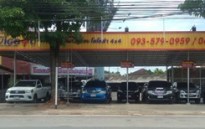[ad_1]
Taxi drivers in the UK must fill in a self assessment tax return if they have worked as a self employed taxi driver at anytime during the financial tax year. Self assessment tax returns should be filed by 30th September each year although the final deadline is the following 31st January. Failing to file the taxi accounts by 31st January attracts a 100 pounds late filing penalty with interest being charged on any tax not paid by this date.
The simplest solution to preparing the taxi driver accounts is to collect all the taxi receipts and expenses together, hand them over to an accountant who will prepare your self assessment tax return and might charge between 150 to 450 pounds for the privilege. That is taxing. Taxi driver accounts does not have to be that taxing. You can prepare your taxi driver accounts and self assessment tax return yourself but do something.
These taxi driver notes in preparing the taxi driver accounts and completing the self assessment tax return are to assist that process.
Mileage Allowances
Taxi drivers can claim as an alternative to vehicle running costs mileage allowances of 40p for the first 10,000 miles and 25p per mile thereafter. You may not claim mileage allowance and vehicle running costs. Should you choose to claim the mileage allowance then keep good records of mileage covered, purpose of journey.
Taxi Capital Allowances
If you bought a vehicle in the financial year 2007-08 and used the vehicle as a taxi you can claim a first year writing down tax allowance of 25% of the cost of the taxi, restricted to 3,000 pounds for vehicles costing over 12,000 pounds. On vehicles purchased in previous tax years you can claim 25% writing down allowance on the balance not yet claimed. Many taxis are bought and sold each year and where a taxi is sold the capital tax allowance that can be claimed is the difference between the written down value for tax purposes and the amount of sale proceeds. First year allowance on non vehicle assets in the current tax year 2007-08 is 50% for small businesses.
Taxis bought on Hire Purchase
Claim capital allowances on the original cost of the vehicle, interest and other charges count as business expenses and go in the self assessment tax return box 3.61 Other Finance Charges
Taxi Running Costs
When completing the self assessment tax return taxi drivers should enter fuel costs in box 3.46 cost of sales not motoring expenses. A standard check carried out by any competent inland revenue inspector enquiring into a self assessment tax return would be to check when the taxi driver was on holiday and examine if fuel receipts had been included for this period. Not many tax returns are enquired into as the system is based upon trust but taxi drivers should ensure their accounts do not contain this fundamental tax fiddle. Taxi running costs also include repairs, servicing and parts including tyres, road tax, taxi insurance and AA/RAC membership. Taxi administrative costs and expense items such as hiring the radio should be entered under general administration expenditure.
Household expenses
If you run your taxi business from home you can claim a proportion of household expenses as business expenses in the taxi accounts. Household expenses are likely to be disallowed unless they are either specific to the business or a specific area of your home is devoted entirely to your taxi business. Using part of a room part time would not be sufficient to include the household expenses in the taxi driver accounts.
Spouse Costs
You can claim expenses for partners who work for your taxi business and payments up to 100 pounds per week would not attract income tax or national insurance however any payments claimed in the taxi driver accounts must be real payments for real work done. As the claiming of a partner wages as a valid business expense is an area potentially open to abuse the Inland Revenue naturally take a strict view on such claims. Care is required to justify the partner as an expense.
Other Expenses
Enter all business expenses in a named expense box on the self assessment tax return. Avoid entries in box 3.63 Other Expenses if possible as any significant amounts in this box may give rise to an Revenue enquiry into the self assessment tax return.
The better and more detailed a taxi driver keeps records of incoem and expenditure throughout the year offers the best chance to pay the least taxxes at the end of that year. This is because with meticulous records every self employed taxi driver can then do the calculation of whether to claim mileage allowances ot vehicle running costs. Without good records the most tax efficient option cannot be made. The decision to claim mileage allowance or taxi running costs can and often does change during the financial year. In general when a more expensive taxi cab is purchased then the capital alloweance of 3,000 pounds will often outweigh the potential mileage allowance although if the vehicle is low value the mileage allowance might be the best option and a method of saving valuable tax pounds which you are entitled to. The best taxi accounting software will automate the comparison of taxi mileage allowances with taxi running costs doing the taxi accountants work for you.
[ad_2]
Source by DIY Accounting

 2/1 Rattanakosin Road,
Si Phum, Muang, Chaing Mai
CONTACT# 0932387148
2/1 Rattanakosin Road,
Si Phum, Muang, Chaing Mai
CONTACT# 0932387148
 19/8 Moo.3 Makham
Tia, Muang, Surat Thani.
CONTACT# 0935790959, 0986716951
19/8 Moo.3 Makham
Tia, Muang, Surat Thani.
CONTACT# 0935790959, 0986716951

